Skin Tag and Wart Removal London
Home » Treatments » Skin Tag and Wart Removal London
Get your warts removed today!
Get in touch now, there is no reason for you to wait.
Award winning dermatology service, with over 20 years of experience
Short waiting lists, on some occasions offering same week appointments
Safe environment, in Care Quality Commission approved facilities
Treating Skin Tags, Warts and Verrucae In London.
Skin tags are small, harmless growths that hang off the skin and look similar to warts. They are typically flesh-coloured or brown and vary in size from a couple of millimetres up to 5cm wide. Anyone can develop skin tags at any stage in their life, but they’re most common in older people and those with diabetes; pregnant women may also develop them due to hormonal changes.
Warts are caused by the human papilloma virus, which enters the skin surface, causing growth and thickening of the top (epidermal) layer of the skin. This produces the rough, hard texture of a wart. The strain of HPV that causes warts and verrucas is different from the ones that are linked to cervical cancer, so you can get a wart or verruca even if you have had the HPV vaccine.
Verrucas are simply warts that have formed on the sole of the foot. Since they are under pressure from the foot, verrucas are usually flatter than warts. Verrucas are also more likely to feel painful, because of this pressure.
WHAT DO WARTS AND VERRUCAE LOOK LIKE?
Warts appear most often on the hands and feet, though they can spread to other parts of the body, for example around the nails, lips and genitals. Verrucas are warts that develop on the soles of the feet. Warts vary in appearance depending on where they are on the body and how thick the skin is but the common wart is often round, firm and raised, with a rough or ‘warty’ surface (see pictures). On close inspection, many tiny black dots may be seen in the centre, caused by ruptured blood vessels. These ruptured blood vessels are more likely to be seen on verrucas, because they have been compressed underneath the foot.
Warts and verrucas can be classified into several different types based on how they look:
- Common wart: a round, raised growth with a rough surface that is sometimes compared to the texture of a cauliflower. These types of warts are usually seen on the hands and can grow up to 1cm across, although most are just a few millimetres in diameter.
- Plantar wart or verruca: a wart on the sole of the feet that usually looks flattened and has tiny black dots in it where the blood vessels have burst. Clusters of verrucas can sometimes join together to form mosaic warts.
- Flat or plane wart: a smooth, round growth that can be flat or slightly raised. These types of wart often appear on the face, neck, legs or the backs of the hands. Sometimes they form large clusters of tend or even hundreds of warts.
If you notice any unusual growths or patches on your skin then it is always best to get them checked by an expert. Although it is probably just a wart or verruca, there is a small chance that a growth could be something more serious such as a skin cancer.
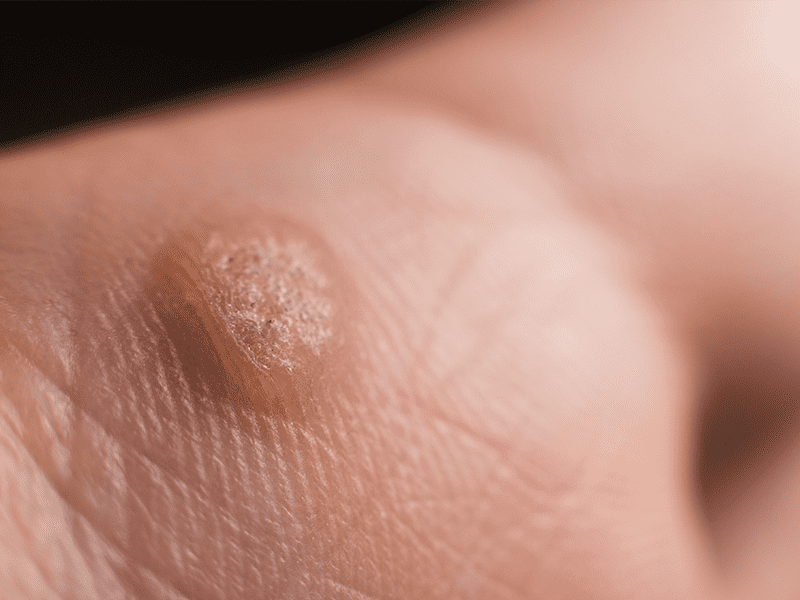
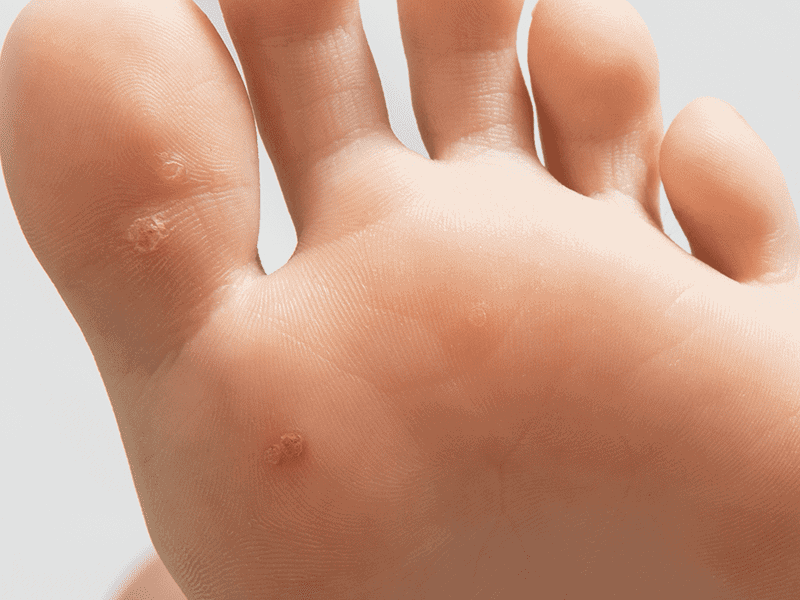
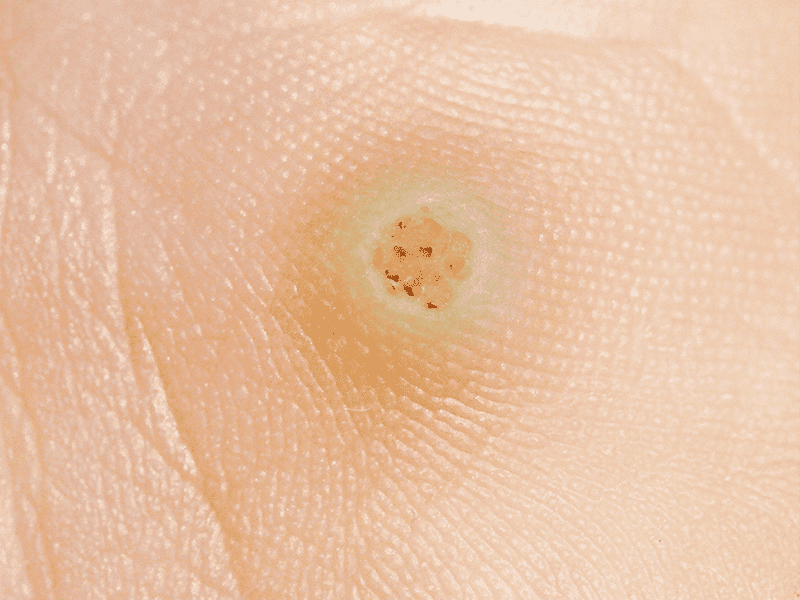
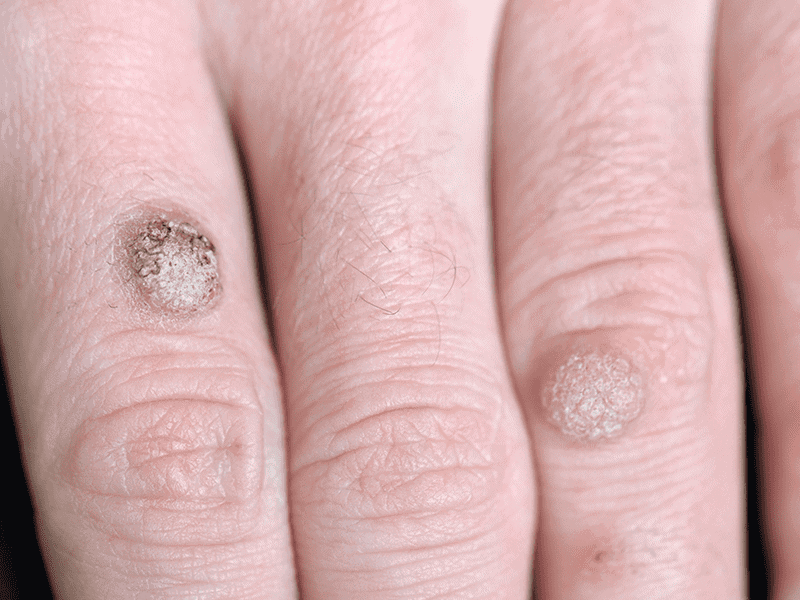
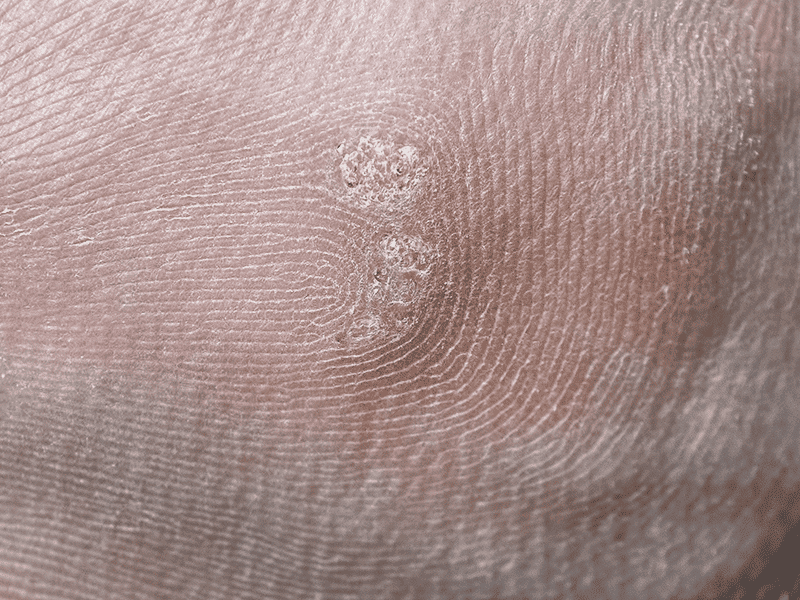
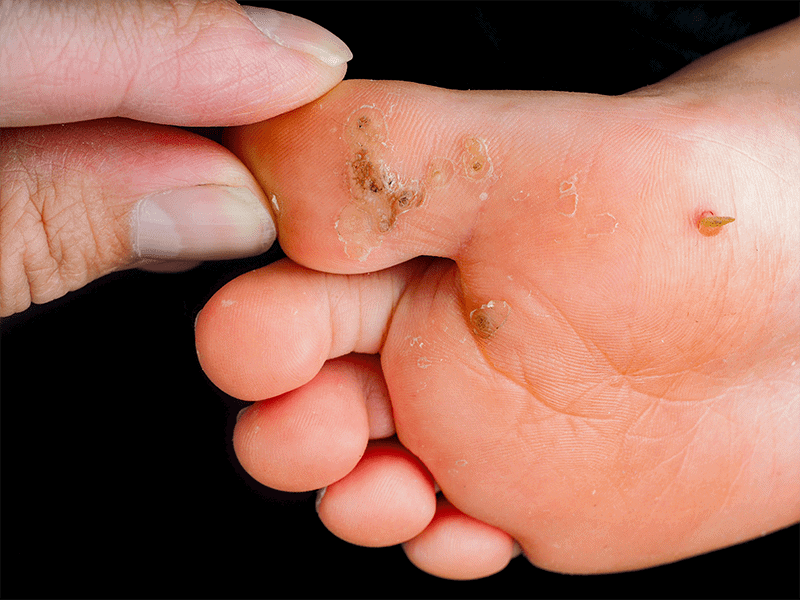
HOW ARE SKIN TAGS, WARTS AND VERRUCAE TREATED?
Our team of dermatology specialists are able to remove skin tags, warts and verrucae via methods including snip cautery, cryotherapy (liquid nitrogen) and/or laser treatment. Skin tag or wart removal is perfectly safe and effective, leaving little to no lasting marks of their existence.
If you’d like to find out more about our skin tag or wart removal options please get in touch and we’ll be happy to answer your questions and book you in for a consultation with one of our skin specialists.
SKIN TAGS AND WARTS TREATMENTS INCLUDE:
- Laser Treatment
- Cryotherapy
- Curettage & Cautery
- Diphencyprone (DCP)
SNIP CAUTERY
Electrocautery uses a small probe to accurately introduce an electric current into the wart material with the aim of cauterising the blood supply. Occasionally, this is combined with curettage (scraping off the wart) with prior local anaesthetic injection to numb the area. This is often the treatment of choice for a single symptomatic wart.
CRYOTHERAPY
Cryosurgery is sometimes used very successfully. The treatment involves liquid nitrogen to kill off the infected tissue. Usually multiple treatments at 2 to 3 week intervals are required Success is greater if combined with wart paints in between cryotherapy treatments.
LASER TREATMENT
Lasers that target haemoglobin can also be successful, as the laser can accurately target the blood supply to the wart without causing painful peripheral damage. The laser energy penetrates the wart material, heating up and sealing the blood supply so that the wart cannot survive. The pain involved is generally less than cryosurgery or electrocautery and one treatment is sometimes enough to kill the growth entirely.
DIPHENCYPRONE (DCP)
New to the Harley Street Dermatology Clinic is a treatment for difficult warts with immune therapy – Diphencyprone (DCP). When DCP is applied to the skin, it boosts the immune response in the skin and this helps to clear the virus responsible for causing warts and verrucas. 80-90% of patients with warts will respond to treatment with DCP. If your warts have not responded to standard therapies, there is a good chance they may be cleared with DCP therapy.
FREQUENTLY ASKED QUESTIONS
SKIN TAG OR WART?
Skin tags and warts can often be mistaken for one another, and whilst neither is typically painful or cancerous, warts are contagious and can spread easily so it’s best to have them removed by a specialist.
Skin tags can commonly be found on the neck, in the armpits, under the breasts, in the groin area, on the eyelids, or on the bottom, among other places. Most of the time they are harmless and don’t cause any pain or discomfort. However, depending on where they are located you may find that they rub or snag on your clothing causing some amount of discomfort. In addition to this, skin tags can sometimes be unsightly and can cause the person to feel self-conscious or embarrassed by their presence.
There are a few ways that you can tell if you’re dealing with a skin tag or a wart:
- Skin tags tend to be smooth and soft, whilst warts are typically rougher with an irregular surface
- Warts usually lay flat on the skin, whilst skin tags are knobbly and hang off the skin
- Warts are contagious and tend to develop in sudden outbreaks and clusters, whilst skin tags are not contagious and tend to be isolated in their appearance
HOW COMMON ARE WARTS AND VERRUCAE?
Most people will have warts at some point in their life, though they tend to affect children and young adults. Warts are generally not painful, though verrucae can be sore to stand on. Some people find their warts embarrassing and those on the fingers may interfere with normal daily activities.
Without treatment, the length of time it takes a wart to disappear will vary between people. As a rough guide, about a third of warts have gone within three months, and most will have resolved within 2 years. Verrucae can take a lot longer than this to disappear.
HOW CAN I PREVENT WARTS AND VERRUCAE FROM SPREADING?
- Wash your hands after touching a wart or verruca
- Change your socks daily if you have a verruca
- Cover warts and verrucae with a plaster when swimming
- Take care not to cut a wart when shaving
- Don’t share towels, flannels, socks or shoes
- Don’t bite your nails on fingers with warts on
- Don’t walk barefoot in public places if you have a verrucae
- Don’t pick or scratch at them
WHAT IS THE DIFFERENCE BETWEEN A WART AND VERRUCAE?
Warts and verrucas are growths caused by the same virus on different parts of the skin. Warts can appear anywhere on the body, although they are most common on the hands. Verrucas are warts that form on the soles of the feet. Since verrucas are squashed under the foot, they can look a bit different from other warts. Verrucas are usually flattened and often have dark specks as a result of tiny blood vessels being crushed inside them. The same kinds of treatments can be used on warts and verrucas.
ARE WARTS AND VERRUCA CONTAGIOUS?
Warts and verrucas are caused by a virus that can spread from one person to another. The chances of this happening are generally low, but it is more likely if the skin is wet or damaged. It’s therefore important to take precautions to prevent this such as wearing waterproof plasters while swimming or not sharing towels. The virus can also spread from one part of your skin to another, so you should try to avoid scratching or picking at the affected areas. It is also best to keep the skin dry as much as possible, so make sure that you are drying yourself thoroughly after baths or showers. You should also avoid sharing your towels with other people to avoid spreading the virus to them.
HOW DO YOU CATCH WARTS AND VERRUCAS?
Warts and verrucas happen when a strain of the Human Papilloma Virus (HPV) gets into the outer later of the skin. The infection causes the skin to thicken, creating a small growth known as a wart or verruca. Viruses like HPV can’t usually get into the skin, but it can happen when the outer layer of skin is wet or damaged. This is why warts and verrucas often spread at public swimming pools, where people are touching the same surfaces with wet skin.
HOW COMMON ARE WARTS AND VERRUCAS?
Warts and verrucas are so common that most people will have them at some point in their lives. Some people are more likely to catch the virus that causes warts and verrucas, especially if they have a condition or are taking medication that weakens their immune system. Children are also more likely to be affected. This is because they have less developed immune systems and are more likely to spend time swimming or in close contact with each other while playing. Approximately 1 in 10 children will be affected by warts of verrucas.
ARE GENITAL WARTS THE SAME AS OTHER WARTS?
Genital warts are similar to the warts and verrucas that appear on other parts of your skin, but they are caused by a different strain of HPV that can’t affect other areas. Genital warts are considered a sexually transmitted infection (STI) because they can be spread through sexual contact. If you have warts in the genital area then it is important to see your GP or visit a sexual health clinic as they will require a different type of treatment than other kind of warts.
DO I NEED TO GET TREATMENT FOR WARTS AND VERRUCAS?
Warts and verrucas are generally harmless. In time, they will often go away by themselves, but this could take more than a year. If you’re unsure whether a growth is definitely a wart, you’re uncomfortable or embarrassed about it, or you just don’t want to wait for it to disappear, then you should seek treatment. The wart or verruca can be removed.
WHAT HAPPENS IF WART AND VERRUCA TREATMENT DOESN'T WORK?
Getting rid of warts and verrucas can be tricky. You might have tried over the counter wart and verruca removal products without any success before seeing a doctor or the treatment your dermatologist provided might not have worked at first. Sometimes it takes a while to find the treatment that will work for you. Your dermatologist can offer a number of different wart treatments, so if one of them doesn’t work there will usually be another option to try. For example, diphencyprone or DCP therapy is a new treatment for warts and verrucas that can be particularly effective when they haven’t responded to the other options.
CAN A WART OR VERRUCA BE HARMFUL?
Warts or verrucas won’t cause any serious complications, but they can be a bit painful or uncomfortable. You might also feel self-conscious about them if they are in a visible place. However, there is a small chance that you might mistake another type of growth for a wart or verruca, so it is best to get them checked by an expert just in case. You can see a dermatologist for treatment or ask a pharmacist to confirm that you have a wart or verruca.
WHAT ELSE COULD A GROWTH ON MY SKIN BE?
If you have a growth that looks like a wart or verruca, then that is the most likely diagnosis. Another possibility is that the growth is a corn, which is a small and harmless growth that can appear where skin has been under pressure (for example where your shoe has been rubbing). There are also some types of skin cancer that can look similar to warts so it is important to consult an expert if you’re not sure what it is. It is especially important to see a doctor if the growth is painful, itchy, growing quickly or bleeding. Although it could still be a wart or another benign growth, there is a chance it could be something more serious that require immediate treatment.
HEAR FROM OUR PATIENTS
Start Your Journey With Us
Please fill in this form and one of our team will give you a call back to arrange a consultation with one of our expert dermatologists.
WHY TREAT YOUR SKIN TAGS, WARTS OR VERRUCAE AT THE HARLEY STREET DERMATOLOGY CLINIC?
Having the right dermatologist is important especially when you have a chronic skin condition that will require ongoing treatment. We want you to feel confident that we’re providing you with the best possible care. We also want you to feel as comfortable as possible with your dermatologist.
The Harley Street Dermatology Clinic specialises in conditions affecting the skin, hair and nails. Our goal is to provide all the care that you need when you’re experiencing these kinds of problems. We want to make it easy for you to access the best quality wart removal in London.
The clinic is conveniently located in Central London, so it’s easy to visit us if you need to see a dermatologist. You will find yourself in a very comfortable and welcoming environment. We have created a relaxing space where you will receive the highest quality of care. We are regulated by the Care Quality Commission, are part of the British Association of Dermatologists and are top rated by patients of Doctify so you can be sure of safe and effective treatment with us
latest INSIGHTS AND ADVICE
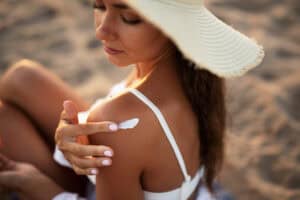
Shield Your Skin, Save Your Youth – The Ultimate Guide to SPF
Unlocking the Power of Sunscreen Ever wondered why the skincare shelves are brimming with products boasting SPF? For many skincare beginners and health-conscious individuals, navigating the world of sun protection can be overwhelming. But don’t worry, we’ve got you covered. In this guide, we’ll explore

Acne Awareness Month: Understanding, Treating and Managing Acne
June is Acne Awareness Month – a time dedicated to understanding and addressing one of the most common skin conditions affecting individuals worldwide. Acne Awareness Month serves as a reminder of the importance of education, support and access to effective treatments for those struggling with acne.
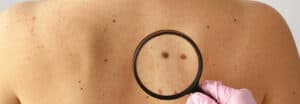
May is Melanoma Awareness Month
Every year, May marks an important moment for the world’s collective fight against melanoma, the deadliest form of skin cancer. It’s a time when the healthcare community amplifies its efforts to educate and engage the public about the risks, prevention strategies, and the latest advancements







